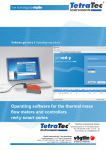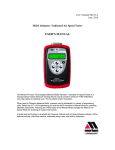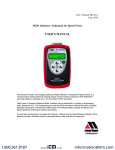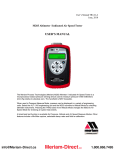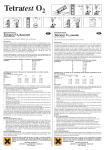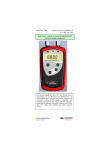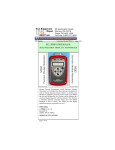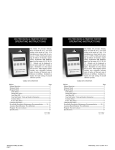Download USER'S MANUAL - TetraTec Instruments GmbH
Transcript
User’s Manual 9R122-IR Rev 1 May, 2010 User’s Manual 9R122-IR Rev 1 May, 2010 M203 Altimeter / Indicated Air Speed Tester USER’S MANUAL Meriam Process Technologies’ M203 Altimeter / Air Speed Tester is a microprocessor based pressure sensing device used to measure pressure up to 900 mm Hg relative to absolute zero. When used in Pressure Measure Mode, pressure can be displayed in a variety of engineering units. Select the ALT / IAS engineering unit and the M203 converts to Altitude Mode for checking altimeter instruments. Pressing the TARE button from Altitude Mode changes the M203 to Air Speed Mode for checking air speed instruments. A timed leak test function is available for Pressure, Altitude and Air Speed Measure Modes. Other features include a Min/Max capture, selectable damp rates and field re-calibration. Table of Contents User Interface.................................................................................1 1. Keypad Functions..................................................................1 ON/OFF & BACK W KEY ......................................................1 MIN/MAX & UP S KEY .........................................................1 TARE & DOWN T KEY ........................................................1 PRGM & ENTER X KEY.......................................................2 BACKLIGHT KEY ..................................................................2 2. Zeroing the Manometer .........................................................3 3. Program Mode.......................................................................7 Units Select................................................................................8 ALT / IAS (Altitude / Indicated Air Speed) Mode .......................9 Damp Rate Select .................................................................. 11 User Info Select (Accuracy, SW version, Mfr date, SN) ......... 12 Auto Shut-Off .......................................................................... 13 Lockout Select ........................................................................ 14 Header Name ......................................................................... 15 Contrast Select ....................................................................... 16 Data Logging .......................................................................... 17 Leak Test ................................................................................ 19 Re-Calibration......................................................................... 21 RE-CALIBRATION – 1 Point EDIT and START ..................... 22 RE-CALIBRATION – 5 Point EDIT ......................................... 23 RE-CALIBRATION – 5 Point START ..................................... 24 RE-CALIBRATION – Restore Factory Defaults ..................... 25 Specifications .............................................................................. 26 Certification/Safety/Warnings...................................................... 27 Changing the Batteries ............................................................... 27 Contact Information..................................................................... 29 1 2 User’s Manual 9R122-IR Rev 1 May, 2010 User’s Manual 9R122-IR Rev 1 May, 2010 User Interface: 1. Keypad Functions PRGM & ENTER X KEY Puts the manometer into the Program Mode from the Measure Mode. When in the Program Mode, pressing this key selects the programmable register to be edited (with prompt for password if Lockout is set). After the register has been edited, pressing the PRGM key enters the new setting into the manometer’s non-volatile memory. This key also acts as a forward space f key when editing user inputs such as the header name. ON/OFF & BACK W KEY Turns the manometer on and enters the unit into the Measure Mode. Pressing the key while in the Measure Mode turns the unit off. It also serves as a backspace key when editing in the Program Mode. The key takes the user out of a programmable register without changing the previous setting. Pressing this key repeatedly will return the user to the Measure Mode and then shut off the manometer. BACKLIGHT KEY The BACKLIGHT key, represented by the standard light bulb symbol, toggles the display backlight between on and off. MIN/MAX & UP S KEY In the Measure Mode activates the Min/Max function of the manometer. When activated the minimum value is displayed on the upper left of the display and the maximum value on the upper right. This key also deactivates and resets this function. The c key is used to scroll through the programmable registers when the unit is in the Program Mode. Once a programmable register is selected the c key can be used to edit that register. TARE & DOWN T KEY In the Pressure Measure Mode, toggles on/off the Tare function. The Tare function nulls the applied pressure and sets the display value to “0”. With Tare activated, the letter “T” appears in the lower left of the display. In the ALT / IAS Measure Mode (selected from Program Mode under Units Select menu), the Tare button toggles between ALTITUDE function and AIR SPEED function. The d key is used to scroll through programmable registers when the unit is in Program Mode. Once a programmable register is selected the d key can be used to edit that register. 1 2 User’s Manual 9R122-IR Rev 1 May, 2010 User’s Manual 9R122-IR Rev 1 May, 2010 2. Zeroing the Manometer Keystroke The M203 Precision Smart Manometer is a stable and precise instrument. However, on occasion the M203 should have a new zero taken. This is done to remove zero drift that can occur since the manometer was last zeroed. The M203 can be zeroed only if the new applied zero is within ±1% FS of the original factory calibration zero. This prevents accidental zeroing at atmospheric pressure or other relatively high pressures. If outside this limit a “ZERO RANGE ERROR” message appears and the manometer will not zero. The M203 provides three mechanisms for re-zeroing: 1. Referenced to Absolute Zero: This traditional and preferred method takes a “snapshot” of the measured pressure when a vacuum of less than 100 microns Absolute is applied to the sensor. 2. Factory Zero: This method restores the calibration curve to the original zero taken at the factory. Note that this feature is intended for comparison purposes, and should not be used for real pressure measurement, as any zero-drift since shipment will not be accounted for. 1. Press ON/OFF button. 3. Pull a full vacuum. Display should read close to zero. (See note on next page) 4. Press MIN/MAX and TARE keys at the same time. (See Figure 1 below.) Top line of display reads “ZEROING SOURCE:” Bottom line of display reads “REF TO ABS ZERO” 5. Press the PRGM key. Top line of display reads “ZERO IN PROGRESS” while bottom line counts down from 9. Zeroing is complete when unit returns to Measure Mode. Figure 1 3 The display briefly shows the header name and full scale range in the last engineering units selected. The manometer then goes into the Measure Mode showing the pressure and engineering unit. 2. Connect the M203 to a vacuum source capable of 100 microns absolute or less. 3. User-Adjusted Zero: This method allows the user to enter any pressure value when a known reference is applied (for example, the local barometric pressure reading). The manometer will compare its actual measured value with the entered value, and calculate a new zero reference based on the offset. 1. To zero the manometer using Referenced to Absolute Zero, start with the unit turned OFF and use the following keystroke sequence: Display NOTE: The M203 can be zeroed only if the new applied zero is within ±1% FS of the original factory calibration zero. If outside this limit a “ZERO RANGE ERROR” message appears and the manometer will not zero. Contact the factory for support in this case. 4 User’s Manual 9R122-IR Rev 1 May, 2010 User’s Manual 9R122-IR Rev 1 May, 2010 2. To zero the manometer using Factory Zero, start with the unit turned ON and in Measure Mode. Then use the following keystroke sequence: Keystroke Display 1. Press MIN/MAX and TARE keys at the same time. (See Figure 1 above.) Top line of display reads “ZEROING SOURCE:” Bottom line of display reads “REF TO ABS ZERO” 2. Press S or T arrow key until desired zero function is shown on the bottom line. Bottom line of display reads “FACTORY ZERO” 3. Press the PRGM key. Zeroing is complete when unit returns to Measure Mode. 4. Press the PRGM key. Top line of display shows the current non-zero compensated pressure value. Bottom line of display shows the same value, along with the engineering unit. 5. Press any of S or T arrow key or the PRGM key to begin editing. Top line of display continuously updates. Bottom line of display data is ready for editing; the first character location is blinking. Example: set current pressure value to 29.5 In Hg @ 0º C Abs. 6. Press the S or T arrow key to set the first digit to 0. NOTE: this feature is intended for comparison purposes only and should not be used for pressure measurement as any zero-drift since shipment will not be accounted for. 3. To zero the manometer using User-Adjusted Zero, start with the unit turned ON and in Measure Mode. The use the following keystroke sequence: Keystroke Display 1. Apply a known, accurate pressure source. This may be true atmospheric pressure from a reference barometer. 2. Press MIN/MAX and TARE keys at the same time. (See Figure 1 above.) Top line of display reads “ZEROING SOURCE:” Bottom line of display reads “REF TO ABS ZERO” 3. Press S or T arrow key until desired zero function is shown on the bottom line. Bottom line of display reads “USER ADJ. ZERO” 5 Current: xxx.xx 0xx.xx INHG Using the S arrow key the character sequence is 0 - 9, (-) negative, (.) decimal point. The (-) sign is used if your location is below sea level. 7. When the User Adj. Value is correct press the PRGM key. Cursor flashes to the right of “0”. If an error is made use the back space W key to move the cursor back to the incorrect digit. Press the UP S or DOWN T arrow keys to correct the value. 8. Continue this process until the display reads as shown at right. Current: xxx.xx 029.50 INHG 9. Press the PRGM key to enter the final value. Zeroing is complete when unit returns to Measure Mode. 6 User’s Manual 9R122-IR Rev 1 May, 2010 User’s Manual 9R122-IR Rev 1 May, 2010 Note that the User Adjusted Zero feature will not accept entries in altitude units (FEET or METERS). When the current engineering unit is FEET, the User Adjusted Zero function will automatically prompt for an entry in Inches of Mercury @ 0º C. When the current engineering unit is METERS, the User Adjusted Zero function will automatically prompt for an entry in Millimeters of Mercury @ 0º C. 3. Program Mode The Program Mode is used to configure the manometer for Measure Mode operation. After the PRGM key is pressed in Measure Mode, the top line of the display reads “PROGRAM MODE”. The bottom line reads “UNITS SELECT”. Press the d or S arrow keys to scroll through the Program Mode to the desired register. The configurable registers found in the Program Mode are Units Select, Damp Rate Select, User Info Select, Contrast Select, Data Logging, Leak Test and Exit. Press the PRGM key to select any of these configurable registers. The manometer can be put into Program Mode at any time during Measure Mode operation by pressing the PRGM key. If Lockout is set, the correct code must be entered when prompted (see the User Info / Lockout section of this manual for more information on Lockout). Units Select The standard engineering units available on the M203 are: Inches of Mercury at 0° C (in Hg @ 0° C) (absolute) Millimeters of Mercury at 0° C (mm Hg @ 0° C) (absolute) PSI (absolute) Mbars (absolute) Bars (absolute) kPa (absolute) Torr (absolute) ALT / IAS - selecting this unit gives access to English (knots, MPH and Feet) or Metric (km/h and Meters) units. To change the engineering units the manometer should be “ON” and in Measure Mode. Then follow these steps: Keystroke 1. Press the PRGM key. 2. Press the PRGM key. 3. Press the S or T arrow key until desired engineering unit is displayed. 4. Press the PRGM key to select the engineering unit. 5. Press the T arrow key. 6. Press the PRGM key. 7 Display Top line reads “PROGRAM MODE” and bottom line reads “UNITS SELECT”. Top line reads “UNITS SELECT” and bottom line shows current engineering unit. Engineering units on bottom line of display change. Top line reads “PROGRAM MODE” and bottom line reads “UNITS SELECT”. Bottom line reads “EXIT”. Display returns to Measure Mode in new engineering unit. 8 User’s Manual 9R122-IR Rev 1 May, 2010 User’s Manual 9R122-IR Rev 1 May, 2010 ALT / IAS (Altitude / Indicated Air Speed) Mode The model M203 is capable of displaying altitude (feet or meters based on “U.S. Standard Atmosphere 1962” tables) and air speed (knots, MPH or km/h). The ALT / IAS Mode is selected from Program Mode in the Units Select menu. Once ALT / IAS Mode is selected, the M203’s default measurement is altitude. Pressing the “Tare” key nulls the prevailing barometric pressure and converts the display to air speed indication. To revert back to altitude the “Tare” key is toggled again. To set up the M203 for ALT / IAS Mode use the following steps: Keystroke 1. Press the PRGM key. 2. Press the PRGM key. 3. Press the S or T arrow key until “ALT / IAS” is displayed. 4. Press the PRGM key. 5. a. If ENGLISH units are desired, press the PRGM key. (For METRIC units, Go To Step 6.) 5. b. If KNOTS unit are desired, Go To Step 7. (For MPH units, Go To Step 5.c.) 5. c. If MPH units are desired, press the S or T arrow key until “MPH” is displayed. Display Top line reads “PROGRAM MODE” and bottom line reads “UNITS SELECT”. Top line reads “UNITS SELECT” and bottom line shows current engineering unit. Top line reads “UNITS SELECT” Bottom line reads “ALT / IAS”. Top line reads “UNITS SELECT” and bottom line reads “ENGLISH”. Top line reads “UNITS SELECT” and bottom line reads “KNOTS”. Note: the altitude unit “FEET” is associated with Knots. 5. d. Go To Step 7. 6. If METRIC units are desired, press the S or T arrow key 7. Press the PRGM key. 8. Press the W key. Top line reads “UNITS SELECT” and bottom line reads “METRIC”. Units are set to METERS and km/h. Top line reads “PROGRAM MODE” and bottom line reads “UNITS SELECT”. Manometer returns to Measure Mode displaying Altitude. Important Notes: 1. Altitude is the default measurement when ALT / IAS Mode is active. 2. If ALT / IAS Mode was active upon manual or automatic shut off, ALT / IAS Mode will be restored upon cycling power and altitude will be displayed. 3. When the M203 is displaying air speed and power is turned off (manually or automatically), Program Mode is entered, or the Tare key is pressed, the unit will be returned to altitude display once power is cycled or the unit is returned to Measure Mode. This is a feature designed to prevent errors in air speed measurement, necessary because of the tare function employed on barometric pressure to arrive at air speed measurements. Barometric pressure fluctuates with changes in weather conditions. Reverting to altitude measurement upon powering down, entering Program Mode or pressing the Tare button forces a new tare value to be taken prior to each air speed measurement session. Top line reads “UNITS SELECT” and bottom line reads “MPH”. Note: the altitude unit “FEET” is associated with MPH. 9 10 User’s Manual 9R122-IR Rev 1 May, 2010 User’s Manual 9R122-IR Rev 1 May, 2010 Damp Rate Select Adjustable exponential type damping is available to steady the display when measuring pulsating pressures. The M203 has a range of damping rates; 0.1, 0.2, 0.5, 1, 2, 5, 10, or 25 seconds. Damping is done by averaging new data from the pressure sensor against previously collected data. The microprocessor collects data from the sensor every 0.1 seconds. The display updates every 0.5 seconds, showing the current 0.1 second pressure reading. When set at 25 seconds, the display updates every 0.5 seconds with the average of the previous 25 seconds readings. Therefore, it takes up to 25 seconds from the time pressure is applied until the manometer displays the full scale applied pressure. Min/Max display updates every 0.1 seconds. To set the damp rate: Keystroke 1. Enter Program Mode by pressing the PRGM key. 2. Press the S key. 3. Press the PRGM key. 4. Press the S or T keys until the desire damp rate is displayed on the bottom line. 5. Press the PRGM key. Display Top line reads “PROGRAM MODE”. Bottom line reads “UNITS SELECT”. Bottom line reads “DAMP RATE SELECT”. Top line reads “DAMP RATE SELECT”. Bottom line shows current value. Bottom line shows damp rate settings in seconds. 6. Press the T key. Top line reads “PROGRAM MODE”. Bottom line reads “UNITS SELECT”. Bottom line reads “EXIT”. 7. Press the PRGM key. Returns to Measure Mode. 11 User Info Select (Accuracy, SW version, Mfr date, SN) The User Info Select registers are designed to provide the user with information on the hardware and software in the manometer. This register provides read only information on the sensor’s accuracy, software version, date of manufacture and serial number. It also allows the user to edit the Auto Shut-Off, Lockout and Start-Up Header Name features. To access the User Info Select registers, follow the steps below. To configure a User Info Select register, follow the steps shown on the following page. Keystroke 1. From the Measure Mode press the PRGM key. 2. Press the S arrow key twice 3. Press the PRGM key. 4. Press the S arrow key. 5. Press the S arrow key. 6. Press the S arrow key. See instructions to set AUTO SHUT-OFF later in this manual. 7. Press the S arrow key. 8. Press the S arrow key. See instructions for using LOCKOUT later in this manual. 9. Press the S arrow key. See instructions for editing the Header later in this manual. 10. Press the W arrow key to go back to “USER INFO SELECT” screen. Display Top line reads “PROGRAM MODE” and bottom line reads “UNITS SELECT”. Bottom line changes to “USER INFO SELECT”. Bottom line shows accuracy Software version no. shown. Manufacture date shown. Top line reads “AUTO SHUT OFF” and bottom line reads “ENTER TO SELECT”. Bottom Line shows Serial No. Top line reads “LOCKOUT CODE” and bottom line reads “ENTER TO SELECT”. Top line reads “HEADER NAME” and bottom line reads “MERIAM”. The cursor flashes at bottom left. Top line reads “PROGRAM MODE” and bottom line reads “USER INFO SELECT”. 12 User’s Manual 9R122-IR Rev 1 May, 2010 User’s Manual 9R122-IR Rev 1 May, 2010 Auto Shut-Off Lockout Select Enabling the Auto Shut-Off feature allows the manometer to turn itself off after a user selected period of keypad inactivity. Selectable options include DISABLED, 10 Minutes (which is the factory shipped default), 20 Minutes, 30 Minutes, 45 Minutes and 60 Minutes. Disabling this feature limits the manometer to being turned off by using the ON/OFF key only. Enabling the Lockout feature prevents unauthorized users from making changes to the configuration of the manometer. To enter the Program Mode, the user must first enter the “password” (two-digit Lockout Code) within approximately 40 seconds when prompted. Failure to enter the correct two digit code within approximately 40 seconds will return the unit to Measure Mode. Any two-digit numeric code can be programmed. The factory Lockout Code of 00 (which is the default as shipped from the factory) disables the Lockout. To configure auto shut-off follow these steps: Keystroke 1. Follow steps 1-6 in the User Info Select table. 2. Press the PRGM key, then the up or down arrow keys until the desired shutoff time is shown. 3. Press the PRGM key. 4. Press the left arrow key three times. Display Top line reads “AUTO SHUT-OFF” and bottom line reads “ENTER TO SELECT”. Top line reads “AUTO SHUT-OFF” and bottom line toggles to “DISABLED”, “10”, “20”, “30”, “45” and “60” minutes . Desired Auto Shut-Off time is selected, top line reads “AUTO SHUT-OFF” and bottom line reads “ENTER TO SELECT”. Returns to Measure Mode. Note: The “Auto Shut-Off” timer is suspended during Data Logging and Leak Test sessions to prevent accidental loss of information. Auto Shut-Off is re-instated after completion of Data-Logging or Leak Test sessions. To set the Lockout Code follow these steps: Keystroke 1. From the Measure Mode press the PRGM key. If the Lockout is set, enter the correct “password” when prompted. 2. Press the up arrow key twice. 3. Press the right arrow key then the up arrow key four times. 4. Press the right arrow key, then press the up or down arrow keys to change the first digit. Press the right arrow key to proceed. 5. Press the right arrow key when the desired code is set. Lockout is activated. 6. Press the left arrow key twice. 13 Display Top line reads “PROGRAM MODE” and bottom line reads “UNITS SELECT”. Bottom line reads “USER INFO SELECT”. Top line reads “LOCKOUT CODE” and bottom line reads “ENTER TO SELECT”. Bottom line shows the old Lockout Code. The cursor flashes at the first position while the value is changed, the cursor moves to the right position once the right arrow key is pressed. Top line reads “LOCKOUT CODE” and bottom line reads “ENTER TO SELECT”. Returns to Measure Mode. 14 User’s Manual 9R122-IR Rev 1 May, 2010 User’s Manual 9R122-IR Rev 1 May, 2010 Header Name Follow the steps below to edit the Header Name. Keystroke 1. From the Measure Mode press the PRGM key. 2. Press the up arrow key twice. 3. Press the PRGM key. 4. Press the up arrow key five times. 5. If header is correct press backspace key. If editing is desired proceed to step 7. 6. Press the left arrow key. 7. Press the up or down arrow keys to set the correct alpha-numeric value. 8. Press the right arrow key to accept entry. 9. Repeat steps 8 and 9 until the desired Header is shown. 10. If an error is made press the back arrow key until the cursor is over the incorrect value. Follow step 8 to correct. Press the right arrow key to advance the cursor without changing values. 11. When the Header is complete press the PRGM key until header accepted. 12. Press the left arrow key. Display Top line reads “PROGRAM MODE” and bottom line reads “UNITS SELECT”. Bottom line changes to “USER INFO SELECT”. Bottom line shows serial number. Top line reads “HEADER NAME” and bottom line reads “MERIAM”. The cursor flashes at bottom left. Top line reads “PROGRAM MODE” and bottom line reads “USER INFO SELECT”. Returns to Measure Mode. Displays a number between 0 and 9, a letter from A to Z, / or a blank space. Contrast Select The Contrast Select register allows the user to adjust the character contrast of the LCD display to provide the best visibility for the ambient light conditions. To adjust the contrast, follow these steps: Keystroke 1. From the Measure Mode press the PRGM key. 2. Press the S key three times. 3. Press the PRGM key. 4. Press the S or T keys to increase or decrease the contrast value. A low number gives maximum contrast and a high number gives minimum contrast. 5. Press the PRGM key. Cursor advances one space to right. 6. Press the W key. Display Top line reads “PROGRAM MODE” and bottom line reads “UNITS SELECT”. Bottom line reads “CONTRAST SELECT”. Top line reads “CONTRAST SELECT”. Bottom line shows a numerical value. LCD lightens or darkens depending on the value set. Top line reads “PROGRAM MODE” and bottom line reads “UNITS SELECT”. Returns to Measure Mode. If an error is made during the contrast adjustment, pressing the e key returns the display to the previous contrast setting. Top line reads “PROGRAM MODE” and bottom line reads “UNITS SELECT”. Returns to Measure Mode. 15 16 User’s Manual 9R122-IR Rev 1 May, 2010 User’s Manual 9R122-IR Rev 1 May, 2010 Data Logging Data Logging can be used to record pressure measurements. Two record modes are supported: automatic and manual. In automatic mode, a pressure value is captured every 5 seconds for 20 minutes, resulting in 240 stored values. In manual mode, a pressure value is captured each time the PRGM key is pressed up to 240 values. The data collected during a logging session can be viewed upon completion. Keystroke 1. From the Measure Mode press the PRGM key. 2. Press the up arrow key five times. 3. Press the PRGM key. 4. Press the PRGM key. 5. Press the PRGM key at AUTO to start automatic logging or at MANUAL to start manual logging mode. 6. To stop recording values at any time, press the ekey. 7. To access recorded values, press the c key. 8. To view recorded values, press the PRGM key. 9. Press the ekey 3 times. The Auto Shut-Off” timer is disabled for Data Logging sessions. Be sure to end the session to re-enable the Auto Shut-Off timer. Display Top line reads “PROGRAM MODE” and bottom line reads “UNITS SELECT”. Bottom line reads “DATA LOGGING”. Top line reads “DATA LOGGING” and bottom line reads “RECORD”. Top line reads “RECORD MODE” and bottom line reads “AUTO” or “MANUAL”. Top line reads “RECORDING X” and bottom line reads “XX.XX UNITS”. AUTO records value every 5 seconds. Manual records value each time PRGM key is pressed. Top line reads “DATA LOGGING” and bottom line reads “RECORD”. Top line reads “DATA LOGGING” and bottom line reads “VIEW”. Top line reads “DATA LOG: 1” and bottom line displays the value. Continue pressing the c key to view all values. Returns to Measure Mode. 17 18 User’s Manual 9R122-IR Rev 1 May, 2010 User’s Manual 9R122-IR Rev 1 May, 2010 Leak Test The Leak Test feature allows the user to determine the leak rate in the pneumatic system being monitored. Once configured, Leak Test monitors the measured pressure, altitude or air speed over time and displays the leak rate in units per minute at the conclusion of the test. The maximum configurable leak test period is 1440 min (1 day). Pressing any key during the leak test aborts the test. The “Auto Shut-Off” timer is disabled for Leak Test sessions. Be sure to end the session to re-enable the Auto Shut-Off timer. To enable Leak Test follow these steps: Display Keystroke 1. From the Measure Mode Top line reads press the PRGM key. “PROGRAM MODE” and bottom line reads “UNITS SELECT”. 2. Press the down arrow Bottom line reads “LEAK key twice. TEST” 3. Press the PRGM key. Top line reads “LEAK TEST” and bottom line reads “CONFIGURE”. 4. Press the PRGM key. Top line reads “Leak Test Period” & bottom “X.X MIN”. 5. Use the up, down & right Bottom line reads desired keys to input test period period; Ex. “ 20.0 MIN”. 6. Press the PRGM key. Top line reads “LEAK TEST” and bottom line reads “CONFIGURE”. 7. Press the up arrow key Top line reads “LEAK once. TEST” and bottom line reads “PRGM TO START”. 8. Press the PRGM key. Top line displays MIN/MAX pressure values at left/right. Bottom line reads the current pressure value and units. 9. Press the PRGM key. At end of test period, top line displays the leak rate in units per minute. Bottom line shows the current pressure reading. Return to Measure Mode 19 20 User’s Manual 9R122-IR Rev 1 May, 2010 User’s Manual 9R122-IR Rev 1 May, 2010 Re-Calibration RE-CALIBRATION – 1 Point EDIT and START The Manometer can be re-calibrated in the field for zero, span, and linearity. The proper primary standards must be available prior to calibrating the Manometer. These standards should meet the accuracy requirements for your company or industry. Meriam Process Technologies follows the guidelines established by ANSI / NCSL Z540-1-1994 which requires that the primary standard be 4 times more accurate than the unit under test. To perform a 1-point re-calibration, apply a pressure between 50% and 100% of Full Scale and then follow these steps: The re-calibration is not intended to replace the Factory Lab Calibration Procedure. It is intended to correct the curve fit if the actual sensor characteristics change slightly over time. For sensors up to 200 PSI, Meriam recommends a ±0.0015% of reading deadweight tester. If calibrating using inches or millimeters of mercury, be sure to match the reference temperature of mercury in both the M203 and the deadweight tester. The reference temperature for these units in the M203 is 0º C. 1-point (within upper 50% of Full Scale), 5-point (nominal values of 0%, 25%, 50%, 75% & 100% of Full Scale), and restore factory default re-calibration options are offered. For the 5-Point re-calibration, points 2, 3 and 4 can be adjusted within ±1% of reading around the nominal values. Point #5 can be adjusted within ±1% of reading around nominal. Point #1 is fixed at zero. For example: for a 900 mm Hg Abs sensor (nominal 17 PSIA), Point # 2 (25%) can be edited form 216 to 234 mm Hg Abs. Point #5 (100%) can be edited from 891 to 900 mm Hg Abs. The unit can only be re-calibrated if the calibration points are within 5 times the accuracy of the original factory calibration (e.g. @ 0.05% accuracy, the point limit is ±0.25% of Full Scale). If the re-calibration procedure generates a new value outside this limit the procedure will fail. In this case the unit would need to be returned to the factory for service. Once a re-calibration has been performed (either 1-point or 5point) the unit will continue to allow future re-calibrations only with that type of re-calibration. In order to enable the other recalibration type, the user must first restore the re-calibration data to the factory defaults. 21 Keystroke 1. With unit OFF, press and hold the MIN/MAX key, turn the unit on by pressing the ON/OFF key, then release MIN/MAX. 2. Press the up arrow key until “START” is displayed on the bottom line. 3. Press the PRGM key. 4. Press the PRGM key. 5. Press the up/down arrow keys to edit the selected digit. Use the left/right arrow keys to change the cursor position. Value entered must be 50100% of FS. 6. Press the right arrow key while on the right most digit to proceed. 7. Apply the input pressure indicated using an appropriate reference standard; press PRGM key. 8. Press the left arrow key. Display Top line reads “RE-CAL”. Bottom line reads “EDIT”. Top line reads “RE-CAL”. Bottom line reads “START”. Top line reads “RE-CAL START”. Bottom line reads “1POINT”. Top line reads “CAL POINT” and bottom line displays the cal point value. Bottom line displays the cal point value. The cursor flashes at the first position while the value is changed, then moves to the right position when the right arrow key is pressed. Top line reads “APPLY:” Bottom line displays the “CAL POINT” value. Top line reads “RE-CAL”. Bottom line reads “START”, Manometer has been recalibrated. Returns to Measure Mode 22 User’s Manual 9R122-IR Rev 1 May, 2010 User’s Manual 9R122-IR Rev 1 May, 2010 RE-CALIBRATION – 5 Point EDIT RE-CALIBRATION – 5 Point START To edit the calibration points for a 5 Point re-calibration follow the steps below. NOTE: If the factory default values are acceptable, skip this section and proceed to the re-calibration 5-Point START procedure. To begin the 5-point re-calibration procedure, turn the unit OFF and follow the steps below. Keystroke 1. With unit OFF, press and hold the MIN/MAX key, turn the unit on using the ON/OFF key, then release 2. Press the PRGM key. 3. Press the up/down arrow keys to edit the selected digit. Use the left/right arrow keys to change the cursor position. Note: For 0% go directly to step 4. 4. Press the right arrow key while on the right most digit to proceed. 5. Repeat steps 3 and 4 for CAL POINTS 2, 3, 4 and 5. 6. After editing CAL POINT 5 press the right arrow key while on the right most digit to proceed. 7. To perform the 5-point re-cal, press the up arrow key until START is displayed on the bottom line. OR To exit without performing the 5-point recal press the left arrow key Display Top line reads “RE-CAL”. Bottom line reads “EDIT”. Top line reads “CAL POINT 1”. Bottom line displays the cal point value. Bottom line displays the cal point value. The cursor flashes at the first position while the value is changed, then moves to the right position when the right arrow key is pressed. Top line reads “CAL POINT 2”. Bottom line displays the cal point value. Top line reads “CAL POINT 2/3/4/5”. Bottom line displays the cal point value. Top line reads “RE-CAL”. Bottom line reads “EDIT”. Top line reads “RE-CAL”. Bottom line, “START”. Continue with 5-Point Recalibration procedure at step 3 on next page. OR Returns to Measure Mode. 23 Keystroke 1. Press and hold the MIN/MAX key and turn the unit on by pressing the ON/OFF key. 2. Press the up arrow key until “START” is displayed on the bottom line. 3. Press the PRGM key. 4. Press the up arrow key until “5-POINT” is displayed on the bottom line. 5. Press the PRGM key. 6. Vent P1 and P2 ports to atmosphere and simultaneously press the MIN/MAX and HOLD keys, then release. 7. Press the right arrow key while on the right most digit to proceed. 8. Apply the indicated calibration point pressure using external pressure standards. After pressure is stable, press the right arrow key. 9. Repeat step 8 for CAL POINTS 4 and 5. 24 Display Top line reads “RE-CAL”. Bottom line reads “EDIT”. Top line reads “RE-CAL”. Bottom line reads “START”. Top line reads “RE-CAL Bottom line reads “1POINT”. Top line reads “RE-CAL START”. Bottom line reads “5POINT”. Top line reads “POINT 1 – ZERO:” Bottom line displays live applied pressure. Unit takes new zero. Top line reads “ POINT 1 ZERO:” Bottom line displays live applied pressure. POINT 1 has been taken. Top line reads “POINT 2 APPLY:”. Bottom line displays the cal point value to apply. Top line reads “POINT 3 APPLY:”. Bottom line displays the cal point value to apply. Top line reads “POINT 4/5 APPLY” Bottom line displays the cal point value. User’s Manual 9R122-IR Rev 1 May, 2010 User’s Manual 9R122-IR Rev 1 May, 2010 10. Use up or down arrow keys to select NO or YES when asked “Save?” the ReCalibration data. 11. Press the PRGM key at YES to save the Re-Calibration data or at NO to exit without saving. 12. Press the left arrow key. Top line reads “SAVE?”. Bottom line reads “NO” or “YES”. Top line reads “RE-CAL”. Bottom line reads “START”. Re-cal is complete. Returns to Measure Mode. RE-CALIBRATION – Restore Factory Defaults To restore the re-calibration data to the factory defaults, follow these steps: Keystroke 1. With unit OFF, press and hold the MIN/MAX key, turn the unit on using the ON/OFF key, then release. 2. Press the up arrow key twice. 3. Press the PRGM key. 4. Use the up and down arrow keys to select YES or NO when asked to restore defaults. 5. Press the PRGM key at YES to restore the Factory Default Calibration data or at NO to exit without restoring. 6. Press the left arrow key. Display Top line reads “RE-CAL”. Bottom line reads “EDIT”. Top line reads “RE-CAL”. Bottom line reads “RESTORE DEFAULTS”. Top line reads “RESTORE DEFAULTS”. Bottom reads “YES” or “NO”. Top line reads “RESTORE DEFAULTS”. Bottom reads “YES” or “NO”. Top line reads “RE-CAL”. Bottom line reads “RESTORE DEFAULTS”. Factory defaults have been restored. Returns to Measure Mode. 25 Specifications Type, Range and Display Resolution: 17.403 psia (900.0 mmHg) – XX.YYY (XXX.Y) Minimum / Maximum Display Values: Altitude: -2000.0 to +36,000.0 Feet -609.6 to +10,972.8 Meters Indicated Air Speed: 0 - 496.4 Knots (approx.) 0 - 571.3 MPH (approx.) 0 - 919.4 km/h (approx.) Note: the barometric pressure value at time the TARE button is activated will determine the maximum indicated air speed. Altitude Accuracy: ±0.02 % F.S. (F.S. = 900 mm Hg) Indicated Air Speed Accuracy: ±0.028 % F.S. (F.S. = 900 mm Hg) Accuracy statements include the combined effects of temperature, non-linearity, repeatability, hysteresis and resolution. Warm up time = 5 minutes. Temperature: Storage = -40°C to +60°C (-40°F to +140°F) Operating = -5°C to +50°C (23°F to +122°F) Media Compatibility: AI: Absolute pressure sensors for use with gases and liquids compatible with 316L SS Pressure Limits: AI units: 77 PSIA (4000 mm Hg Abs) Connection: 1/8” female NPT, 316L SS. P1 is the pressure connection. P2 is not accessible (factory plugged with metal disc) User must use a wrench on the pressure manifold when installing user’s 1/8” NPT fitting. Do not tighten the fitting without using a wrench on the pressure manifold. Failure to use a wrench on the manifold will damage the plastic enclosure and void warranty No torque should be applied to the manifold with respect to plastic enclosure. 26 User’s Manual 9R122-IR Rev 1 May, 2010 User’s Manual 9R122-IR Rev 1 May, 2010 Battery Type: 4 each AA alkaline Battery Operation: >100 hours continuous use, 1 year shelf life, auto power off programmable at Disabled, 10, 20, 30, 60 or 90 minutes Enclosure: (6.9” × 3.8” × 2.3”) Polycarbonate, Permanently Static Dissipative, ESD Protection Enclosure with Boot: (7.2” × 4.2” × 2.5”) Rating: IP 40 Certification/Safety/Warnings Note the following cautions and requirements: • Substitution of components may impair operation and safety • Disconnect power before servicing. • To prevent unsafe conditions, DO NOT mix old batteries with new or mix batteries from different manufacturers DO NOT replace batteries in potentially hazardous atmospheres DO NOT operate in potentially hazardous atmospheres • User must use a wrench on the pressure manifold when installing user’s 1/8” NPT fitting. Do not tighten the fitting without using a wrench on the pressure manifold. Failure to use a wrench on the manifold will damage the plastic enclosure and void warranty No torque should be applied to the manifold with respect to plastic enclosure. Changing the Batteries The manometer is powered by four, 1.5 volt AA size batteries. When the output of the batteries under load drops, the display will alternate between “LOW POWER DETECT” and “REPLACE BATTERY”. Low power may affect performance. The unit should not be used to measure pressure in this condition. All four batteries should be replaced. To replace the battery locate the battery compartment at the bottom rear of the manometer, as shown here. 27 Remove the two screws on either side of the battery cover by turning them counterclockwise until the fully disengaged from the manometer base. Lift the cover from the back of the unit. Remove the batteries by pulling the positive side first straight out of the battery compartment. Note the positive (+) and negative (-) battery polarity markings at the bottom of the compartment, as shown here. To install the four batteries: 1) Make sure polarity of battery matches the markings in the compartment. 2) 1st place the (+) end of the battery into the bottom of the battery slot. 3) Then push in (-) end of the battery until it is seated in the bottom of the battery slot. The battery compartment has stand offs molded into the side of the compartment. When a battery is installed with the polarity reversed, the stand offs prevent the negative battery terminal from contacting the positive terminal in the battery compartment. The unit will not power up when a battery is installed this way. Should this happen, simply reverse the battery to align the polarity. With the batteries secured in the battery compartment, replace the compartment cover. The cover has only one correct alignment. The “WARNING DO NOT OPEN IN EXPLOSIVE ATMOSPHERE” statement on the battery cover must be visible and aligned in the middle of the manometer case. To secure the cover, torque the screws clockwise to 1.6-1.8 in-lbs. Do not over tighten. 28 User’s Manual 9R122-IR Rev 1 May, 2010 User’s Manual 9R122-IR Rev 1 May, 2010 Contact Information If the M203 can not be zeroed, recalibrated or is damaged, it must be returned to the factory for servicing. In this case, contact the Meriam Process Technologies representative in your area or call the factory at the numbers listed below for a Return Material Authorization (RMA) number. Meriam Process Technologies 10920 Madison Ave. Cleveland, OH 44102 Ph. (216) 281-1100 FAX (216) 281-0228 E-mail [email protected] Web www.meriam.com Or contact our sales representative: TetraTec Instruments GmbH Gewerbestr. 8 71144 Steinenbronn Deutschland Tel: +497157 / 5387-0, Fax: +497157 / 5387-10 Internet: www.tetratec.de Email: [email protected] All M203 Altimeter / Air Speed Testers recalibrated at the factory are returned with certificates of NIST traceability. 29 30

















